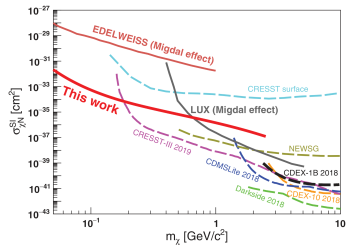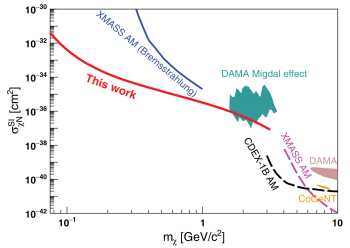On October 15th, CDEX (China Dark matter EXperiment) collaboration, led by Tsinghua University, published an article entitled “Constraints on Spin-Independent Nucleus Scattering with sub-GeV Weakly Interacting Massive Particle Dark Matter from the CDEX-1B Experiment at the China Jinping Underground Laboratory” on Physical Review Letters (Phys. Rev. Lett. 123, 161301). In this work, the most stringent limits on spin-independent WIMP-nucleon cross sections were set for sub-GeV WIMPs (weakly interacting massive particles) with Migdal effect incorporated.
Compelling evidence from astronomical observations have demonstrated the existence of dark matter in the Universe, which plays a very important role in understanding the origin of mass and the evolution of the Universe. One kind of the most popular dark matter candidates is the weakly interacting massive particles, which is a kind of hypothetical massive particle that could interact with ordinary matter via weak force processes. There are three kinds of strategies to detect dark matter: direct detection, indirect detection, and accelerator-driven dark matter production. CDEX collaboration aims at direct searches of light WIMPs with p-type point contact germanium detectors, by detecting the deposited energies when the incident WIMP bombards the target nucleus of the detector and is then scattered off by the nucleus.
In general, the conventional and simplified treatment of WIMP-nucleus (χ-N) scattering is that all the kinetic energy is transferred from χ to nuclear recoil via elastic scattering, and only the nuclear recoil signal is considered. Complexities arise in real physical systems, since the target nuclei in detectors, being part of the atoms, are coupled also to the electrons. There is finite probability that high-energy electrons are ejected via inelastic χ-N scattering processes. The electrons do not follow the motion of the nuclei such that the electrons of the target atom will be ionized. This process is called the Migdal effect. For sub-GeV dark matter, the observable signals due to the electron recoils will be much larger than those of nuclear recoils. Taking this effect into account, the lower reach of WIMP masses (mχ) in direct detection experiments can be substantially extended to domains far below 1 GeV/c2.
New results on the searches of sub-GeV WIMPs via χ-N spin-independent scattering have been reported, with the Migdal effect incorporated. Analysis on time-integrated (TI) energy spectra and annual modulation (AM) effects on CDEX-1B data are performed, with 737.1 kg day exposure and 160 eVee threshold for TI analysis and 1107.5 kg day exposure and 250 eVee threshold for AM analysis, respectively. The sensitive windows in mχ are expanded by an order of magnitude to lower WIMP masses with the Migdal effect incorporated. New limits are derived on spin-independent WIMP-nucleon cross section at 90% confidence level (C.L.) are derived at mχ~50-180 MeV/c2 and mχ~75 MeV/c2-3.0 GeV/c2 in the TI and AM analysis, respectively.


Figure 1: Exclusion plots of TI analysis (left) and AM analysis (right) at 90% C.L., superimposed with results from other benchmark direct search experiments
Zhongzhi Liu, Ph.D. student in Department of Engineering Physics, is the first author of this paper. Prof. Qian Yue, Associate Prof. Hao Ma and Dr. Litao Yang are the co-corresponding authors of this paper. This work was supported by the National Key Research and Development Program of China, the National Natural Science Foundation of China, the Dark Matter Experimental Platform of Tsinghua University and the Tsinghua University Initiative Scientific Research Program.
The original link: https://journals.aps.org/prl/abstract/10.1103/PhysRevLett.123.161301

